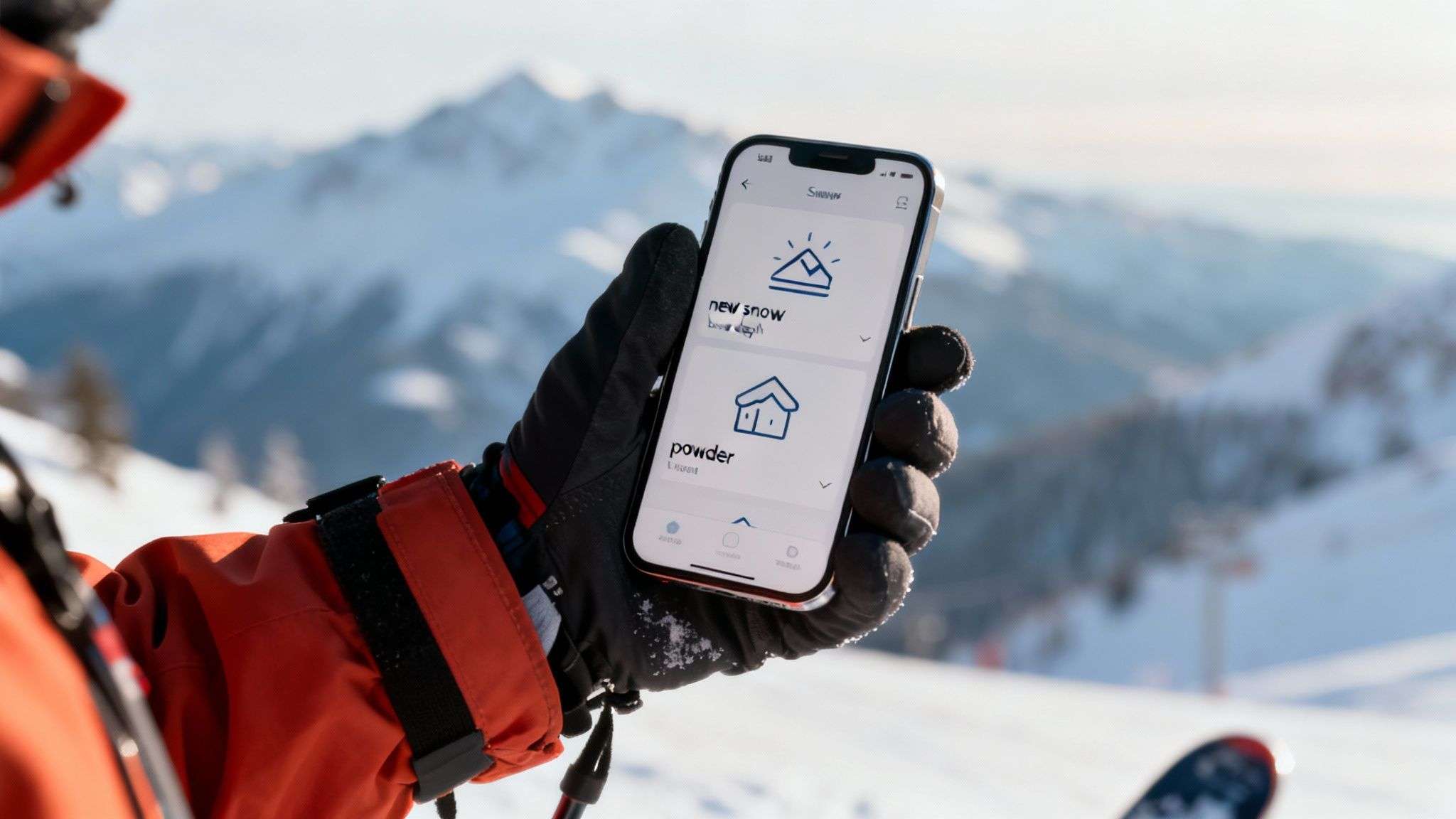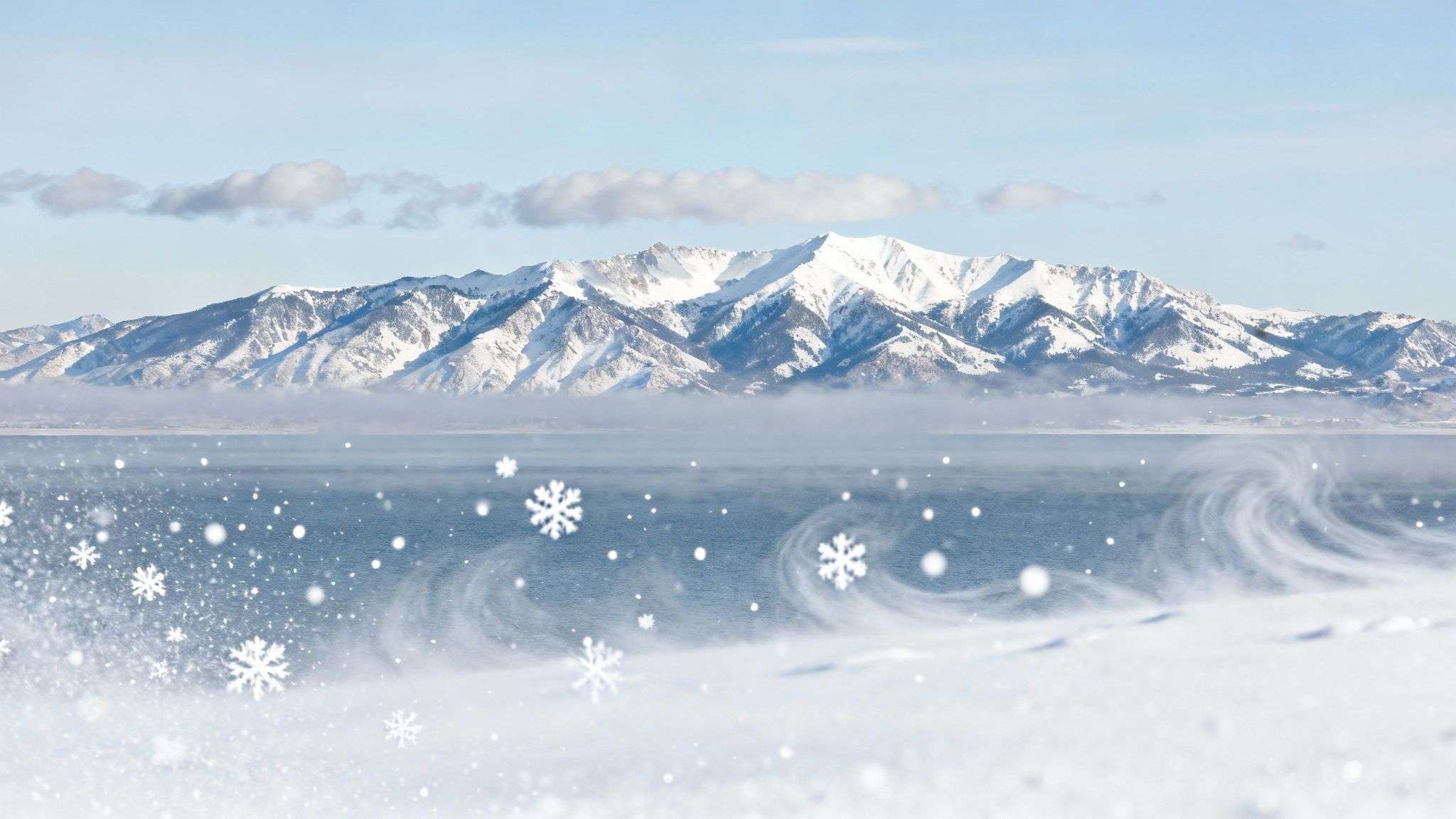A Guide to Snowbird Ski Resort Conditions
Master Snowbird ski resort conditions with this guide. Learn how to read the daily report, find the best snow, and understand the science behind Utah's legendary powder.
Understanding Snowbird ski resort conditions means knowing how its legendary snowfall, high-altitude terrain, and daily snow report work together. This guide provides actionable, local tips to help you read the data, find the best powder stashes, and plan an amazing day in Little Cottonwood Canyon.
What Are the Current Conditions at Snowbird?

Before heading up the canyon, the first step is to check the daily snow report. But reading it like a local goes beyond just the new snowfall number. To truly understand the conditions, you need to look at a few key metrics that tell the full story of what your day will be like on the mountain.
The Wasatch Roads live data feed provides up-to-the-minute details on base depth, new snow in the last 24 hours, and current weather. This is your primary source for real-time information.
How to Interpret the Snow Report
The trick is to use the data to build a strategy. While fresh powder is exciting, the base depth and surface conditions reveal where the best skiing is.
- Base Depth: Think of this as the mountain's foundation. A deep base—over 100 inches—means steep, rocky terrain in areas like Mineral Basin and Gad Valley is filled in and skiing well.
- Surface Conditions: Pay close attention to the vocabulary. "Powder" is fresh, untouched snow. "Packed Powder" has been skied but is still soft. "Machine Groomed" means perfect corduroy for carving, while "Variable Conditions" is a heads-up to expect a mix of everything.
- Lift Status: A classic local's tip is to watch for lifts opening mid-day after being on hold. This often provides access to fresh, untracked terrain long after the morning rush.
Using the report helps you pinpoint exactly where the best snowbird ski resort conditions are at any given moment. For a wider view of how incoming weather will affect these numbers, our complete guide to ski resort weather forecasting will help you see the bigger picture.
When Is the Best Time to Ski at Snowbird?

While Snowbird offers reliable conditions all winter, certain months are better for specific experiences. The best time to go depends on whether you're chasing deep powder, sunny spring days, or a reliable early-season trip.
The resort's legendary snowfall is a product of geography. The "lake effect" from the Great Salt Lake supercharges storms with moisture, which then slams into the steep walls of Little Cottonwood Canyon. This unique funnel effect consistently delivers an average of 500 inches of light, dry powder annually.
A Month-by-Month Look at Snowbird Conditions
- December (Early Season): Snowbird has a dependable early season, with an 84% chance of having over half its terrain open by Christmas. You can count on great skiing on a solid base.
- January & February (Peak Powder): This is the sweet spot. The coldest temperatures and most consistent storms combine to produce the light, fluffy powder Snowbird is famous for.
- March (Deep Base & Big Storms): Often the snowiest month, March brings huge storms that pile up on a deep, stable snowpack, making it a prime time for powder hounds.
- April & May (Spring Skiing): Snowbird is known for its long spring season, often staying open into May. Expect fun groomers in the morning that soften into perfect "corn" snow by the afternoon.
Local Tip: Don't underestimate March. A staggering 40% of winter months at Snowbird see 90 inches or more of snow, and March often delivers the biggest dumps of the year. For a deeper dive into past seasons, check out OnTheSnow's snowfall records for Snowbird.
To stay ahead of the next big storm, keep an eye on our detailed Wasatch snow forecast.
How to Find the Best Snow at Snowbird
Knowing the conditions is one thing; using that information to find the best untracked snow is the real skill. Snowbird's high elevation (11,000-foot summit) and north-facing terrain act like a natural refrigerator, preserving powder for days after a storm.
Actionable Tips for Different Conditions
Your on-mountain strategy should change based on the daily report. Here’s a simple playbook for finding the best stashes based on the current snowbird ski resort conditions.
- On a Powder Day: Everyone heads to the Aerial Tram first. Get one lap, then pivot. The Gad 2 and Little Cloud lifts access incredible terrain that sees less traffic, holding fresh snow longer.
- On a Bluebird Groomer Day: When the sun is out and the snow is firm, stick to the main groomed runs. Chip's Run, the resort's longest at 2.5 miles, is perfect for high-speed carving from top to bottom.
- During a Storm or on a Windy Day: The wind can strip exposed terrain like the Cirque. The smart move is to head for the trees. The runs in Gad Valley offer protection from the wind, allowing powder to pile up and stay soft.
- In Spring Conditions: Mineral Basin is your best bet. Its sunny, south-facing aspect softens up first, delivering perfect corn snow by the afternoon while other parts of the mountain are still firm.
Local Tip: Many of Snowbird’s most famous runs are north-facing, meaning they stay in the shade and are protected from the sun. This is why you can find stashes of cold, soft snow in Gad Valley's trees or Mineral Basin's side shots days after a storm. You can learn more about how Snowbird's unique environment contributes to its amazing winters.

Snowbird’s terrain is spread across 2,500 acres with a good mix of beginner (27%), intermediate (38%), and expert (35%) runs, so there's always a place to find good snow. To get a feel for the mountain's layout before you go, learn about Snowbird's extensive layout and history.
Frequently Asked Questions
What should I know about driving to Snowbird?
The road to Snowbird, Highway 210 in Little Cottonwood Canyon, is a major avalanche zone. When traction laws are in effect, you must have a 4WD/AWD vehicle with snow tires or chains. The road often closes for avalanche control, so always check the UDOT Cottonwoods road status before you leave. The UTA Ski Bus is a great stress-free alternative.
How are the conditions different from Alta?
Snowbird and Alta are neighbors in Little Cottonwood Canyon and share similar snowfall totals. However, Snowbird's terrain is generally considered steeper and more open, with large bowls and long, continuous vertical. While you can access both resorts with an upgraded pass, it's important to remember that snowboarders are only permitted at Snowbird.
For the most current road status and weather intel for your trip up the canyon, the live updates at Wasatch Travel Helper are essential. Plan your drive with real-time data at https://wasatchroads.com.